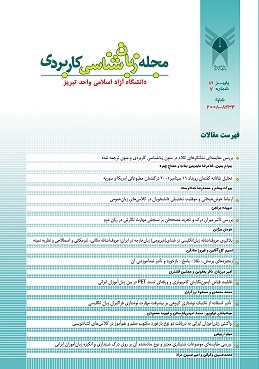A Critical Discourse Analysis of the Event of September 11, 2001 in American and Syrian Print Media Discourse
محورهای موضوعی : English Language Teaching (ELT)بیوک بهنام 1 , محمد رضا خدادوست 2
1 - Tabriz Branch, Islamic Azad University, Tabriz, Iran
2 - Tabriz Branch, Islamic Azad University, Tabriz, Iran
کلید واژه: September 11, 2001, Thematization, Passivization, Nominalization, Synonymy, CDA,
چکیده مقاله :
Aiming at highlighting the important role of print media discourse in the implicit transfer of the dominant ideology of discourse context, the present data-driven paper demonstrates how the lexical features of repetition and synonymy as well as the structural and thematic features of passivization, nominalization and predicated theme were utilized by the discourse producers to mediate between their own underlying ideology and the target readers' understanding of the events of September 11, 2001. Through a comparative statistical analysis of the print media discourse of the data for the study written in two ideologically opposing contexts of Syria and America, we have tried to explicate how the discourse producers utilized various lexical and thematic strategies to produce different impressions of the event and implicitly impose the underlying ideology on the readers.
با هدف نشان دادن نقش مهم گفتمان مطبوعات نوشتاری در انتقال ضمنی ایدولوژی غالب بر بافت گفتمان، تحقیق داده- محور حاضرتلاش کرده است مشخص کند که چطور تولید کنندگان گفتمان ویژگی های واژگانی تکرار و هم معنائی و ویژگی های دستوری و موضوعی مجهول سازی، اسم سازی و موضوع بندی مسندی راجهت انتقال طرز تفکر خاص جامعه خود به خوانندگان هدف به کار برد ه اند تا درک و برداشت مورد نظر خود از حادثه 11 سپتامبر 2001 رابه آنها القاء کنند. با استفاده از روش تحلیل آماری مقایسه ای گفتمان مطبوعاتی نوشتاری داده های تحقیق از دو بافت امریکائی و سوری که از لحاظ ایداولوژی حاکم بر جامعه در دو قطب مخالف قرار دارند، تلاش بر این شد که مشخص شود چطور تولید کنندگان گفتمان رویکردهای موضوعی و واژگانی مختلف را به کار گرفته اند تا تصاویر و برداشت های کاملا متفاوت از حادثه را در اذهان خواننده ها متبادر کنند و به صورت ضمنی ایداولوژی حاکم بر جامعه خود را بر ذهن آنها غالب کنند.
Behnam, B. (2001). Beyond words, our thoughts: a discourse analysis of some texts in Iranian presidential elections. Journal of the Faculty of Letters of Tabriz University, Iran. 44, 178-179.
Bloor, M. & Bloor, T. (2007). The Practice of critical discourse analysis: An introduction. Great Britain: Hodder Arnold.
Brookes, J. H. (1995). The ideological construction of Africa: a critical discourse analysis of news on Africa in the British press. Discourse and society, 6, p. 461-494.
Brown, C. S. (2005). The shot seen around the world: the Middle East reacts to September 11'Th. Middle East Review of International affairs, 5 (4). 69-89.
Fairclough, N. (2005). Critical discourse analysis. Retrieved March 26, 2011 from http://www.ling.lancs.ac.uk/staff/norman/critdiscanalysis.doc
Flowerdew, J. (2008). Toward critical genre analysis. In Bhatia, V., J. Flowerdew, & R. H. Jones (Eds). Advances in discourse studies (pp. 166-167). New York: Routledge.
Fowler, R. (1991). Language in the news: Discourse and ideology in the press. New York: Routledge.
Freedman, R. O. (2005).The Bush administration and the Arab-Israeli conflict: the record of its first four years. Middle East Review of International Affairs, 9 (1).
Halliday, M. A. K. (1985). An introduction to functional grammar. Great Britain: Arnold.
Hodge, R. & .Kress, G. (1993). Language as ideology. (2nded.). New York: Routledge.
Johnstone, B. (2008). Discourse Analysis. Oxford: Blackwell Publishers.
Schemann R. (2001). Hijacked Jets Destroy Twin Towers and Hit Pentagon. New York Times. Retrieved March 27, 2011 from http://topics.nytimes.com/top/reference/timestopics/subjects/s/sept_11_2001/i ndex.ht
Masaki, S. (2009). Japan's media discourse after September 11. Retrieved March 27, 2011 from http://en.parc-jp.org/about/key-statements/japans-media-discourse-after- september-11.
Meyssan T. (2002). Who was behind the September 11th Attacks? A transcribed presentation at Zayed Center in Abu Dhabi, United Arab Emirates. Retrieved June 18'th 2012 fromhttp://search.yahoo.com/search?p=Meyssan+T.+%282002%29.+Who+was+behind+the+September+11th+Attacks%3F+A+transcribed+%09presentation+at+Zayed+Center+in+Abu+Dhabi%2C+United+Arab+Emirates.
Paltridge, B. (2008). Discourse Analysis. London: MPG Books Ltd.
Reath, D. (1998). The language of newspapers. USA: Routledge
Thompson, G. (1996). Introducing functional grammar. London: Arnold Publishers.
Van Dijk, T.A. (2004). From text grammar to critical discourse analysis. Retrieved March, 7 2011from http://www.discourses.org/OldArticles/From%20text%20grammar%20to%20criti cal%20discourse%20analysis.pdf.
World Public Opinion Organization, (2008). International Poll: No Consensus on who was behind 9/11, Retrieved March 27, 2011 from http://www.worldpublicopinion.org/pipa/articles/ international_security_bt/535.php?ni.
Yaghoobi, Mahdi (2009).A critical discourse analysis of the selected Iranian and American printed media on the representations of Hizbullah-Israel war. Journal of International Communication. 21.


